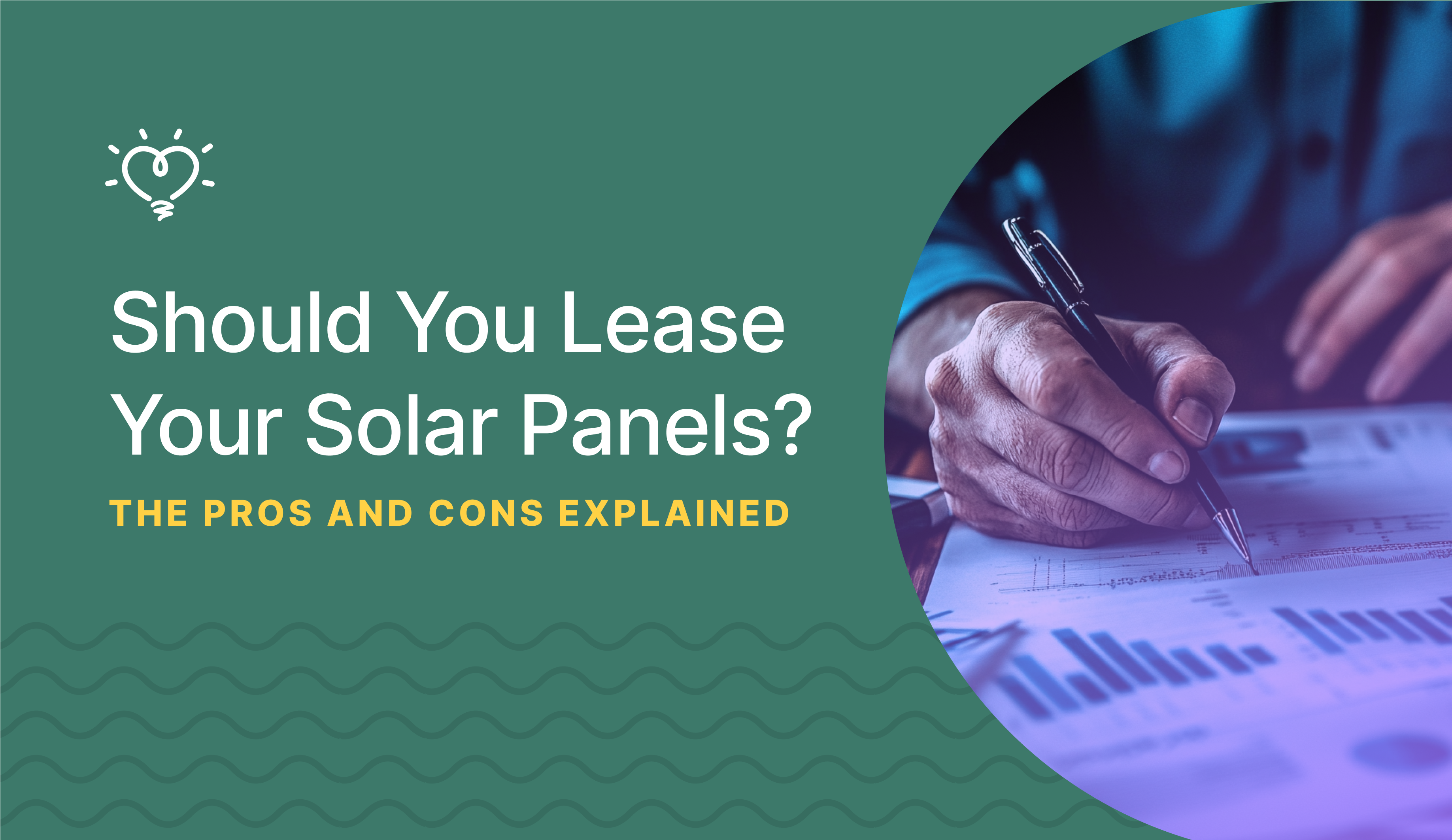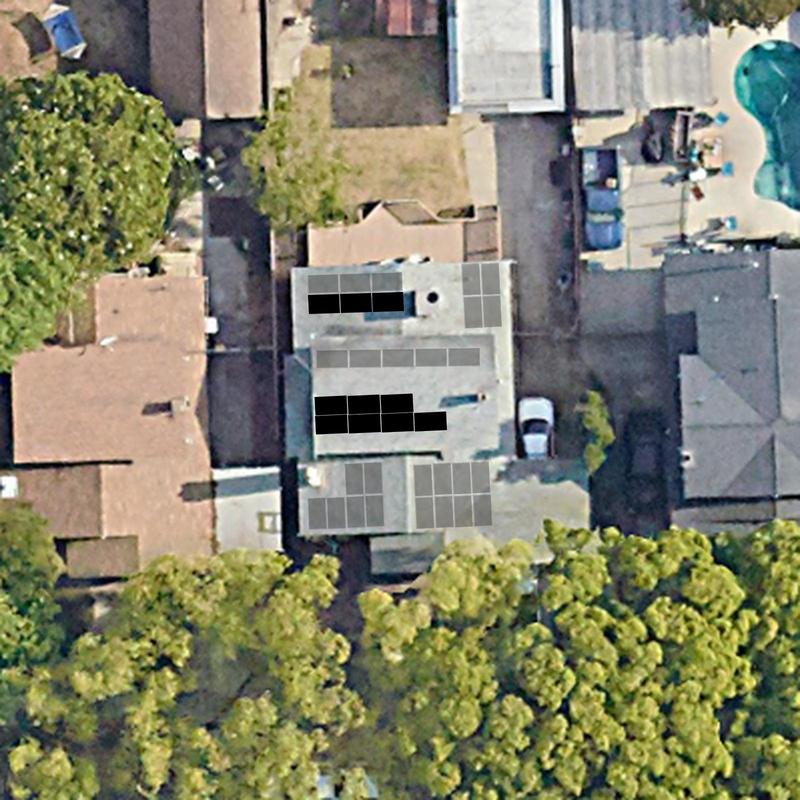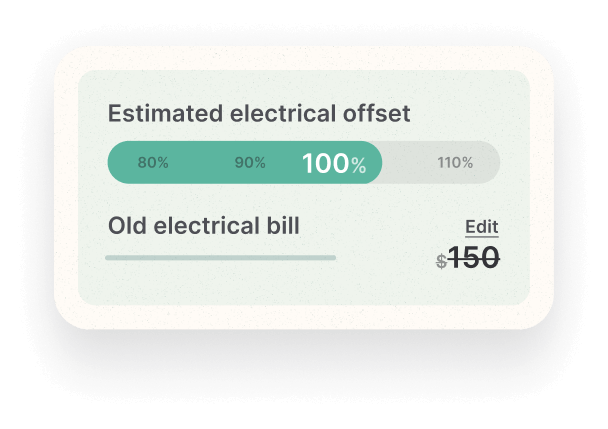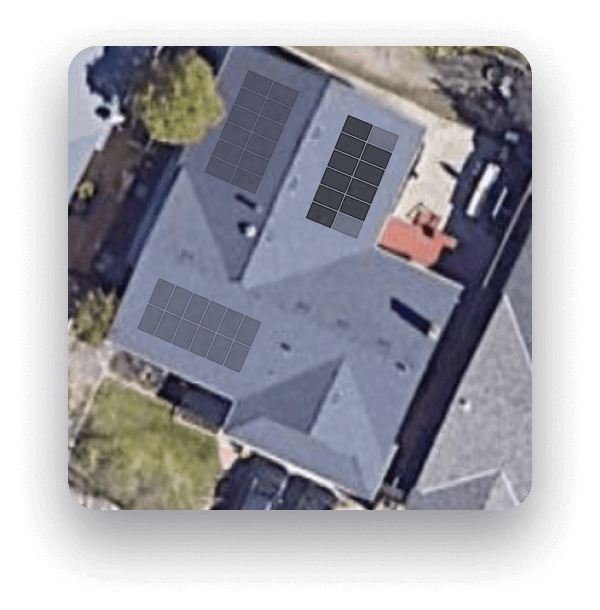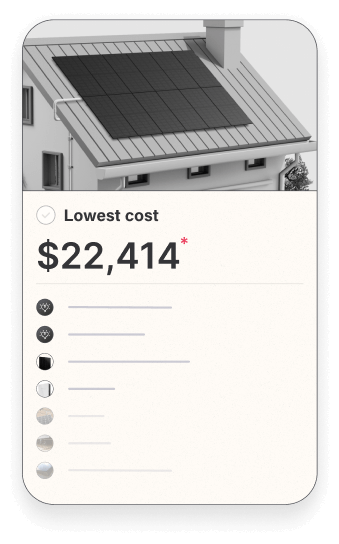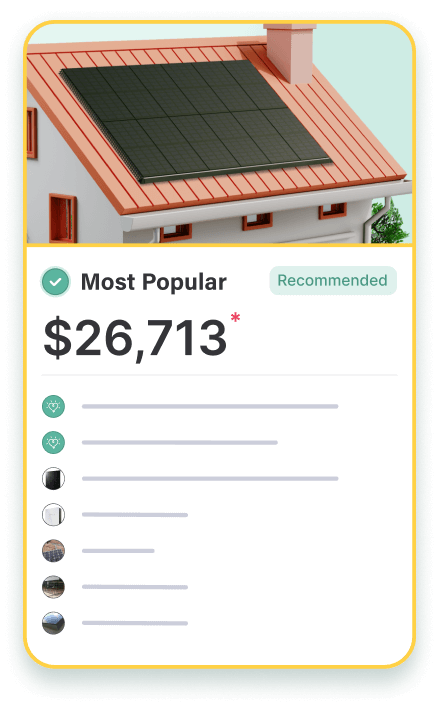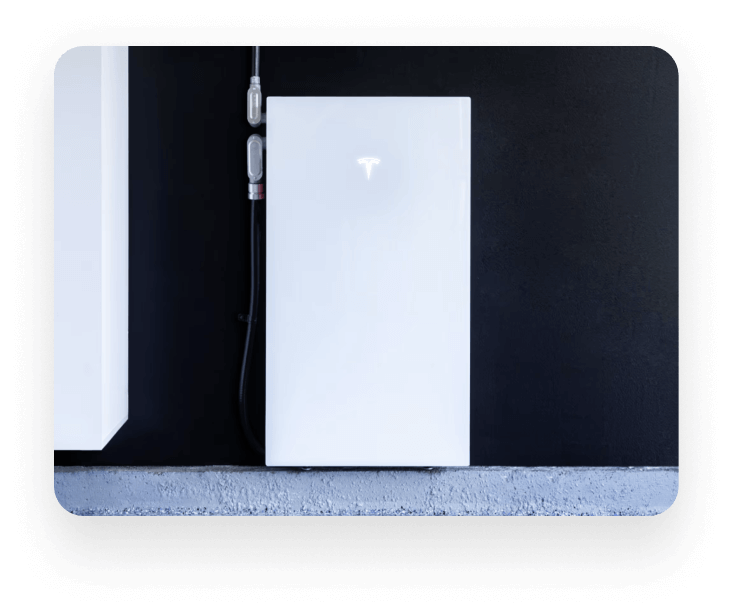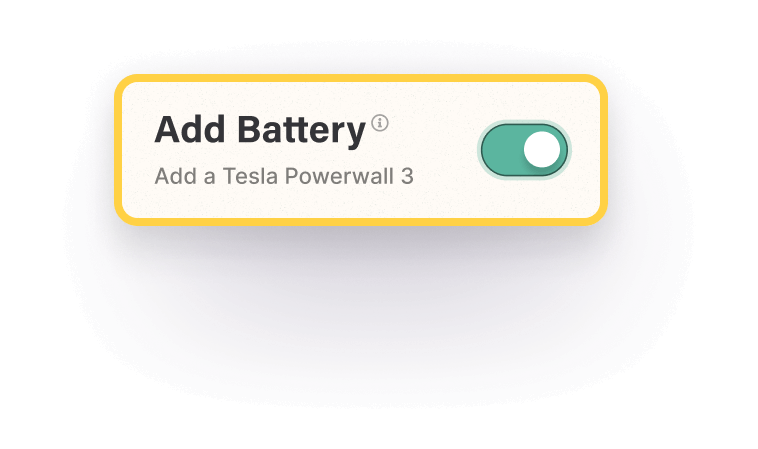#
10 kW system
This refers to system size. Twenty-five panels at 400 watts each equals a 10,000 watts or 10kW system. A 10kW solar system should produce somewhere around 40 kWh (kilowatts per hour) daily, or 40,000 watts per day. The average cost is between $22,000 and $30,000 depending on location and other determining factors.
12 kW system
This refers to system size. A solar system produces at or around 12,000 watts of electricity per hour. A 12 kW solar system will typically produce 48 kWh daily. The average costs before tax credits and financial incentives is approximately $34,200 depending on location and other determining factors.
20 kW system
This refers to system size. A solar system produces at or around 20,000 watts of electricity per hour. A 20 kW solar system will typically produce 80 kWh daily. In the US, the price for this system size ranges from $40,000 to $60,000 before incentives and depending on location and other determining factors. This translates to approximately $2 to $3 per watt.
a
Activation
A term used for turning on one’s solar system so that the solar panels can begin generating power by turning the sun’s rays into electricity. Activation is the final stage of our Monalee process and typically happens one to six weeks after installation. In order to get the go ahead to activate a system, the homeowner must pass the final inspection and receive Permission to Operate (PTO) from their utility company.
Alternating Current (AC)
A type of current that flows in alternating directions and in a back and forth motion. Some examples of electrical appliances with alternating currents include fans, lightbulbs, air conditioners, and motors. Solar energy is direct current (DC), which means that it flows in one direction.
Angle
In residential solar, pitch refers to the angle—or tilt—of a home’s roof. It is one of several factors that determine solar panel efficiency. Solar panels sit just a few inches above the roof, the degree to which the roof slopes impacts how much energy they’ll absorb.
Array
An array refers to multiple solar panels on a roof. Arrays are wired together based on the solar design for that particular roof. In most cases, the more solar panels you have, the more energy your system will produce. This is assuming that your solar panels are working at high efficiency.
Asphalt Shingles
A type of roofing. As the most common type of roofing material, asphalt shingles accommodate many factors homeowners look for in a roof, including affordability, durability, and style. Because of different styles, asphalt shingles look aesthetically pleasing for most home designs and create an even surface for solar panels, but they aren’t the most energy-efficient choice. While new technologies are at work to make asphalt shingles more reflective, traditional shingles absorb a lot of heat (up to 100 degrees) and sunlight, increasing home temperatures and causing shingles to crack and curl over time.
Attic Run
A type of installation setup that runs electrical conduit through the attic rather than on top of the roof, therefore creating a cleaner look. Some HOAs may require attic runs.
Authority Having Jurisdiction (AHJ)
The authority that has jurisdiction in any particular city, state, or county. As every area operates differently, a solar system needs to be designed with local regulations and requirements in mind. This is relevant to permitting, which is required by most–but not all–jurisdictions across the United States.
(roof) Azimuth
The compass direction that solar panels face. A roof in the northern hemisphere that faces south will get the most sun and therefore will be the most efficient. A roof in the northern hemisphere that faces north will get the least amount of sun. The opposite is true for roofs in the southern hemisphere.
b
Backup Battery
A power source that stores excess energy from your solar system. Backup batteries are especially helpful for homeowners who live in areas with frequent power outages. Instead of relying on the local grid for extra electricity, those with battery storage are fully energy independent and protected against blackouts.
Backup Loads
Backup loads are designated devices that are considered essential during a power outage. Many homeowners designate kitchen electronics, such as their refrigerator, stove, and heating as their backup loads. If a blackout does occur, these devices will continue working.
Battery Storage
Another term that refers to a backup battery (see above). For homeowners without battery storage, they can sell the excess energy their system produces to their local grid. This is called net metering.
Bird Netting
Installed between the solar panels and your roof, these mesh barriers deter rodents (as well as leaf build-up) from getting under your solar array.
(Solar) Buyback Credits
A system that is offered by some utility companies in which homeowners can earn credits whenever they offload excess energy from their solar systems to the local grid. Buyback rates are typically based on the state wholesale rate and may vary fluctuate depending on the season.
c
Cedar Shake
A type of roofing. In addition to curb appeal, cedar shake is often 100% natural, durable, and sustainable, making it a great choice for a home. There are a few downsides, though. Extreme temperatures can cause cedar shake shingles to dry out, which leads to splitting. Though cedar shake is known to be resistant to bugs and rot, humid temperatures can impact quality over time.
Circuit
The circular path that electricity flows through. When a circuit breaks, it means that there is no longer a smooth, circular path for electricity to flow.
Clay Tile
A type of roofing. Clay tile is often a disqualifying material for solar panels, and would require a re-roof of a different material in order to move forward.
Climate Technology
A broad term for technology that helps support the environment and combat climate change. These technologies center around reducing greenhouse gas emissions through renewable energy sources such as wind, solar, and hydropower.
(solar) Clipping
An event that occurs when a solar panel or panels are providing more energy than the inverter can handle. It can lead to losing energy for your home.
Composite roofing
By combining materials such as asphalt, fiberglass, rubber, and paper, homeowners can choose a roof style that matches the aesthetic they want without the downsides of that particular material. Composite shingles are highly durable to avoid cracking and splitting and are lightweight, ideal for older homes and structures that can’t withstand the burden of heavier materials.
Computer-aided Design (CAD)
In our case, a CAD refers to the ability to create 3D models of real-world solar arrays before they are installed in real life. A CAD helps our designers and engineers determine the optimal solar array based on factors such as roof pitch, azimuth, and potential obstructions.
Critter Guard
Installed between the solar panels and your roof, these mesh barriers keep rodents (as well as leaf build-up) at bay. They deter rodents and prevent debris from interfering with your solar panels.
d
Derate
To derate is to decrease the size of the main breaker so that the main electrical panel can withstand the amperage load of the solar system. This can be an alternative to getting a main panel upgrade.
Design
A solar design showcases the placement of solar panels on the roof, as well as details on wiring and other logistics. At Monalee, our goal is always to create the most cost efficient design that meets all current code requirements. Photos from the site survey help our designers create the best layout for the panels given the homeowner’s electrical setup.
Direct Current (DC)
A type of current that always flows in the same direction. Solar power is DC because the sun stimulates the flow of electrons in one, single direction.
e
Efficiency
A measurement of how much sunlight a solar panel converts into usable energy. Efficiency is largely determined by the quality of the photovoltaic (PV) cells. Tier One solar panels are among the most efficient models on the market. Monalee installations feature Mitrex M405-L3H solar panels featuring advanced cell technology, high performing modules, and are able to withstand high snow and wind conditions.
Emissions
Substances that are released into the air. Traditional energy generates electricity by burning fossil fuels, which in term releases emissions into the air. Every time coal, oil or gas is burned, both carbon dioxide and nitrous oxide are released. These two greenhouse gasses trap the sun’s heat and are all-around bad for the environment. Using solar energy does not produce air pollution.
Energize
A term that describes the process of turning on, or ‘activating,’ a solar system. In order for a system to be energized, it has to pass the final inspection and be granted Permission to Operate from the homeowner’s utility company.
Energy Audit
A type of audit that identifies areas in your home where you are wasting energy. It also spotlights any potential safety or health risks. An energy audit might look at factors such as insulation, air leaks, heating and cooling systems, lights and ventilation.
Energy Efficient
Well-maintained and functioning solar panels are considered energy efficient. It’s an important metric, and is partially determined by the quality of solar equipment installed. For example, Tier One Mitrex solar panels over 25 years are guaranteed to produce at 90% (having only lost 10% in efficiency during that time period).
Energy Independence
Homeowners who rely on solar energy rather than their local grid are considered energy independent. Those who invest in a solar battery for their system can store the excess energy their system produces and use it at a later time, as opposed to relying on net metering programs because they can still receive credits from their utility company, with or without solar batteries.
Energy Storage
The ability to capture energy and store it until needed. Solar batteries protect homeowners during power outages and allow them to rely less on the local grid.
EV Charging
The capability to charge an electric vehicle using solar panels and an EV charger.
EV Plug
A device that connects to an energy power source. Homeowners can simply plug their EV charger into a 240-volt outlet and their car will be ready to charge.
Equipment
For residential solar, the three main types of equipment include solar panels, an inverter and (possibly) a solar storage battery. Higher-grade equipment such as Tier One solar panels will cost more upfront but have higher levels of long-term efficiency.
f
Federal Tax Credit
The solar Investment Tax Credit (ITC)—more commonly referred as the “solar tax credit”—grants homeowners a 30% tax credit on their installed PV systems (photovoltaic panels, otherwise known as solar panels). Starting in 2033, the solar tax credit drops to 26-percent.
Financing
Going solar is a big investment, but there are many different ways to finance it. Solar financing options include cash payment, solar loans, cash-out refinance or HELOC, and solar lease or power purchase agreements (PPAs). Monalee offers solar loans through Mosaic and GoodLeap.
g
Grid
Being ‘on-grid’ means that your home’s solar system is tied to the local utility grid. This means that, if and when needed, you can power your home with traditional energy.
Grid Parity
Also called socket parity, this is something that occurs when an alternative energy source—such as solar—costs less than or equal to that of traditional energy sources.
Grid-tied Solar Systems
A type of solar system that is linked to both the home’s solar panels and the local utility grid. This means that you can draw power from both energy sources.
Ground Mount Systems
A type of solar system where solar panels are not installed to the home’s roof itself, but rather a dedicated land space. In most cases, workers dig holes into the ground and insert posts for the frame, and then solar panels are attached to that.
h
Heat Detector
A device that acts as fire protection for one’s solar panels. Not to be confused with a fire alarm that detects smoke, heat detectors react and respond to heat.
i
Installation
The process of getting a solar system up and running. At Monalee, we schedule installation shortly after any necessary permits are approved. Installers typically need access to the home’s electrical panels, and possibly, the attic space. Depending on the electrical setup and whether the homeowner has added a battery to their project, installations can take two days to install the hardware.
Interconnection Method
A process of connecting new electricity generators—solar and energy storage in this case—to the local electric grid.
Inverter
An important piece of equipment needed in any solar energy system. They regulate the flow of electrical power and convert direct current (DC) electricity—this is the energy that solar panels generate from the sun—into alternating current (AC) electricity that the local utility grid uses.
Irradiance
The amount of solar radiation per unit area, and measured in W/m2. At Monalee, we run solar irradiance algorithms to see how much sunlight is hitting each area of the roof and optimize panel placement accordingly. Predicting how much sunlight a home gets is a crucial part of our technology. As an example, if there’s a particular tree that casts shade over an area of your roof, our technology will plan around that if possible and instead, place solar panels in unobstructed areas of the roof.
j
Junction box
A component of a solar energy system that protects the necessary wiring connections of a solar system.
Jurisdiction
A local government or legal body that determines solar installation requirements and regulations. Some homes may require additional work in order to move forward, such as a main panel upgrade. When this happens, we work with the homeowner to nail down next steps.
l
Larger Enphase Combiner
A larger combiner panel is required for systems with over 52 solar panels/microinverters. Combiner panels serve as the junction point where the output of multiple solar panels is combined before being fed into the microinverters.
(solar) Lease
A financial agreement in which the company that installs your home’s solar system retains ownership of the system and you pay a fixed monthly fee to use that energy system. Homeowners who opt for a solar lease are required to pay their monthly fee, while the company who owns the system is responsible for covering upfront costs such as installation and any necessary repairs.
Lightweight Tile
A type of roofing. Lightweight tile that is under eight pounds (lbs) is is often a disqualifying material for solar panels, and would require a re-roof of a different material in order to move forward.
Load(s)
A ‘load’ refers to how much energy your home—and specific devices within your home—are consuming. Any device that is connected to a solar panel is considered a load.
Load Relocation
The process of moving a load or loads in order to make room for the solar breaker in the main panel. This often requires additional equipment and labor.
m
Main Panel Upgrade
Whenever panel wiring, breakers, and/or fuses require replacing. While main panel upgrades are typically voluntary, some site surveys will indicate that a new one is required. Updating your electrical panel ensures that it is capable of withstanding the amperage of the solar system.
Metal
A type of roofing material. As a versatile material that has the ability to expand and contract to accommodate heat and weather conditions, metal roofing materials are low-maintenance and can mimic the style of more traditional materials such as shingles or tile. Regarding energy efficiency, metal roofing materials reflect sun and UV rays to reduce the home’s cooling costs.
Microinverter
A type of solar inverter technology that is installed at each solar panel. They are an alternative—often at a higher price point—to traditional string inverters. Some homeowners prefer micro inverters because they allow for rapid shutdown and allow for flexible solar panel layouts.
Mitrex 405 kW Solar Panels
A brand of Tier One solar panels. Mitrex solar panels feature advanced cell technology, high performing modules, and are able to withstand high snow and wind conditions.
Monalee technology
Patent-pending technology that can generate interactive solar panel roof proposals in ten seconds or less by analyzing the roof type and pitch (how much it slopes), and how much sunlight it gets among millions of other data points. It even identifies roof obstacles such as chimneys and roof vents, and designs solar layouts around areas where trees could create shade—an otherwise in-person task that slows down the solar installation process.
n
Net Metering (NET)
A type of billing tool in that homeowners gives homeowners the ability to sell excess energy and recoup that energy at a later date. For this reason, net metering is sometimes referred to as ‘solar buyback,’ or ‘net billing’ and net energy metering (NEM).
New Sub Panel: Back Up Loads
A sub panel that will be used as a backup load panel, meaning that any loads you want backed up by the battery will be relocated to this new sub panel. This may be needed in order to meet the local electrical code and pass inspection.
New Sub Panel: Combiner
A sub panel where multiple inverters are needed. This sub panel will be used to combine the inverters’ outputs into one before connecting to your home’s electrical system.
New Sub Panel: Full main electrical panel
A sub panel needed when the current main electrical panel is full. The installer will need to add a new sub panel in order to make room to connect the solar system.
o
Obstacles
Physical elements placed on the roof–chimneys and roof vents to name a few–that prevent the installation of a solar panel. Also referred to as obstructions.
Off-grid
Homeowners with solar batteries are considered ‘off grid’ because they rely on the excess energy stored in their storage battery rather than the local grid. However, most AHJs don’t allow homeowners to completely disconnect their homes from the grid, so they will be still connected, albeit without purchasing their energy.
Offset
A type of metric that predicts the amount your utility bills will drop to upon switching to solar energy. At Monalee, we always aim to design solar systems that will fully offset a homeowner’s electricity is dependent on the utility’s interconnection type.
p
Permission to Install (PTI)
A permission that is requested once a solar system design is completed and before the solar system is installed.
Permission to Operate (PTO)
A permission needed from the homeowner’s utility company ahead of turning on their solar system. Once this is attained, it is safe to connect the system to the local utility grid and begin producing electricity.
Permitting
The process for ensuring that a proposed solar system meets the local requirements and regulations. After a homeowner’s solar design is finalized, our team compiles their application package and submits it to their local jurisdiction—either online or, in rare cases, directly in person. Some jurisdictions require a permit, while others do not. This process can take as little as a couple hours and up to nine weeks. It really depends on how quickly the local jurisdiction office works through each request.
Pest Abatement
Similar to a critter guard in that it keeps rodents and pigeons from building nests underneath your solar panels and therefore interfering with the wiring.
Photovoltaic (PV) Panel
Also called a solar panel, is a device that converts sunlight into electricity.
Plane
A roof’s plane is an even, uniform, or smooth part of the roof with the same pitch and azimuth.
Pitch
A roof’s pitch refers to the angle at which it tilts or slopes. A roof pitch between 15 and 40 degrees will keep solar panels in the sun longer compared with other setups.
Power Outage
A disruption to the supply of electricity, which results in homes losing power. For solar batteries to work during a blackout, they require ‘blackout protection,’ a feature that allows the battery to power the home without it connecting to the local grid.
Power Purchase Agreement (PPA)
A type of financial arrangement in which the homeowner pays the solar company a non-fixed monthly fee based on the amount of energy generated in that particular month. As with solar leases, homeowners who go the PPA route are not required to pay upfront costs for installation and maintenance. Leases and PPAs offer the least amount of savings when compared to financing and cash, whereas owning your own system offers unlimited savings.
PPW (Price Per Watt)
A means to predict how much switching to solar energy will cost a homeowner. According to Forbes, Solar panels cost between $2.40 and $3.60 per watt including installation, so the price of one’s system depends on how many watts they need to keep their home powered.
PV Disconnect
Often built into solar inverters, a solar PV disconnect (also called a DC disconnect) is what shuts off the direct current of power traveling from the solar panels to the inverter.
PV Inverter
Also known as a solar inverter, a PV inverter is a type of inverter that converts direct current of the PV modules into grid-compliant alternating current and feeds this into the public grid (source: SMA).
PVC Membrane
A type of roofing. PVC membrane is often a disqualifying material for solar panels, and would require a re-roof of a different material in order to move forward.
r
Racking
A typeof structural hardware system that affixes solar panels to different roof surfaces.
Reroof
The process of laying new shingles over an existing layer of shingles–not to be confused with a roof replacement. This might be needed if/when a home’s roof type is not compatible with standard solar equipment.
(Flat) Roof
A style of roof and one that may require a specialized attachment. One of the downsides of having a flat roof is that they may accumulate more debris and grime and require more regular maintenance. Conversely, roofs that are tilted benefit from the rain naturally washing debris and build-up away. Any roof with a slope pitch of less than 10-degrees is considered flat.
Steep Roof 45+
A roof that is set at an angle of 45-degrees or more, and therefore considered steep. When the pitch is at this high of an angle, it creates more hazardous conditions for the installation crew. This will usually result in additional labor costs so that the installers have access to extra safety equipment.
Roof Mounts
A type of solar module racking usually made of sturdy, strong aluminum rails. They feature various rail lengths so as to work with a variety of solar equipment.
Roof Replacement
The process of replacing the roof of a home–not to be confused with a re-roof. It usually involves replacing the roof with a new material.
s
Single Line Diagram
A simplified drawing that showcases the most important information and components that comprise a solar system electrical design. Also known as Schematic Diagrams or an SLD sheet.
Site Survey
A type of site inspection that is conducted ahead of solar design and installation. These visits are important because they allow the solar company to get a deep understanding of a home’s roof and electrical setup. In some cases, a site survey will reveal that upgrades are needed. If this happens, it’s usually because the homeowner’s main panel is out of date or there isn’t enough room for the breakers.
Slate
A type of roofing material. Slate and tile roofing are more expensive than shingles, but their longevity more than makes up for the cost in the long run. These materials can last between 50 and 200 years, depending on the climate and the care that goes into maintaining the roof. Another benefit of slate roofing is that it’s a highly durable and natural material resistant to mold, temperature, fire, and water damage. Slate roofing is a disqualifying material for solar panels, and would require a re-roof of a different material in order to move forward. Slate roofing sometimes comes in synthetic slate, which is also a disqualifying material for solar.
Synthetic Slate
A type of roofing. Synthetic slate is often a disqualifying material for solar panels, and would require a re-roof of a different material in order to move forward.
Smart Panel Upgrade
A type of panel upgrade that lets homeowners control their panel through WiFi with the SPAN smart electrical panel. The homeowner will have WiFi control of their panels and be able to turn the breakers on and off remotely. Remote load shedding is also possible.
SolarEdge
A type of PV monitoring platform in which a homeowner can track how much energy their system is producing, among other metrics.
Solar Access
The ratio of the insolation in a given location, including shade, to the insolation available at that location without shade. Solar access is typically expressed in percent for a given time period, such as a month, season, or year.
Solar Energy
Heat from the sun that can be captured and converted into other forms of energy. It’s a type of renewable energy that is also the cleanest energy available to us.
Solar Panel
Devices that convert sunlight into electricity and heat. They are also known as photovoltaics and are made of photovoltaic (PV) cells. When the sun hits the cells, they release electrons and create an electric charge.
Solar Renewable Energy Credits (SRECs)
Applicable in some US states, solar renewable energy credits work similar to vouchers in that homeowners can earn one SREC for every 1,000 kWh (or 1 MWh) of electricity produced by a solar system. This is measured annually for several years, depending on the state’s SREC policy. These credits/certificates are then sold for their market value, which is close to $40 in some states and, in higher-valued ones, up to $80.
Solar Skirt
An add-on for any solar system. Solar skirts help hide the presence of electrical wires and railings while reducing access under your panels for pests such as pigeons and squirrels.
Solar Storage
The presence of a solar battery that is used for storing excess energy produced by a solar system.
String inverter
Unlike micro inverters which are directly mounted on each solar panel, string inverters are mounted on the home itself. String inverters convert the electrical currents from all of the solar panels. At Monalee, we use the Tesla Solar Inverter, which has native integration with other Tesla products including their app and Powerwall 3.
t
Tesla Inverter
A brand of inverter. The Tesla Solar Inverter has native integration with other Tesla products including their app and Powerwall 3. It also has over-the-air updates and monitoring via Wi-Fi, Ethernet and cellular connectivity (source: Tesla).
Tesla Powerwall 3
Tesla’s latest powerwall model that is made with an integrated inverter that can handle up to 20 kW DC of solar. This new model offers between 20-30% more continuous power compared to the Tesla Powerwall Plus.
Tilt and Orientation Factor (TOF)
The solar insolation at the actual tilt and orientation divided by the insolation at the optimum tilt and orientation, expressed in percent.
Total Solar Resource Fraction (TSRF)
The ratio of insolation available accounting for both shading and TOF, compared to the total insolation available at a given location at the optimum tilt and orientation and with no shading. TSRF is also expressed as a percentage. TSRF = solar access x TOF.
Trenching
A process of digging a long and narrow trench or trenches in order to bury wires and cables—often done so as a safety measure. Trenching is a good idea when a solar array is being planned on a separate structure from where the electrical panel that we will be connecting to is located.
u
Underground Feeder (UF)
A type of cable that is used for interconnecting a PV array.
v
Voltage
A means to describe the pressure that pushes electricity. The higher the voltage, the more electricity that flows.
w
Warranty
A written guarantee that a brand’s equipment–solar, in this case–will work efficiently for a specific period of time. At Monalee, we offer homeowners a lifetime equipment warranty as well as a lifetime labor warranty.
Watts
A way to measure how much electricity a solar panel can produce. It refers to the maximum amount of electricity it can produce when the ideal conditions are met.
Wood Shake
A type of roofing. Wood shake is is often a disqualifying material for solar panels, and would require a re-roof of a different material in order to move forward.
z
Zenith Angle
The angle of the direction of the sun measured clockwise north from the horizon (source: https://catalyst.earth/). This is important when designing a solar system because the zenith angle determines whether clouds heat or cool the surface.
Zero net energy
Having a zero net energy home means that you are producing as much renewable energy as your home needs without relying on the local grid. This is actually more achievable than one might think. In fact, simple lifestyle tweaks like sealing up cracks and other openings around the house make a big difference in reducing one’s energy needs.





